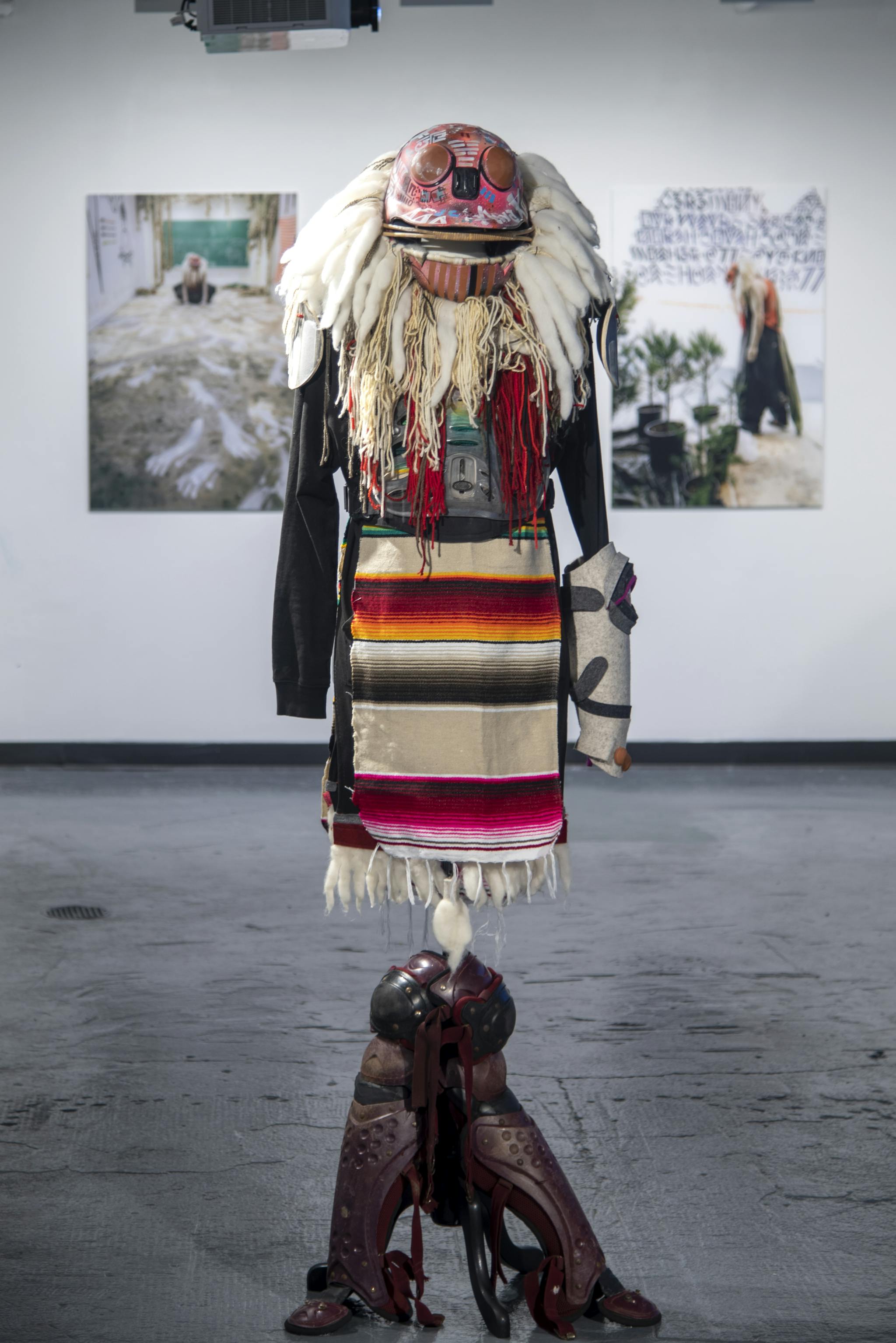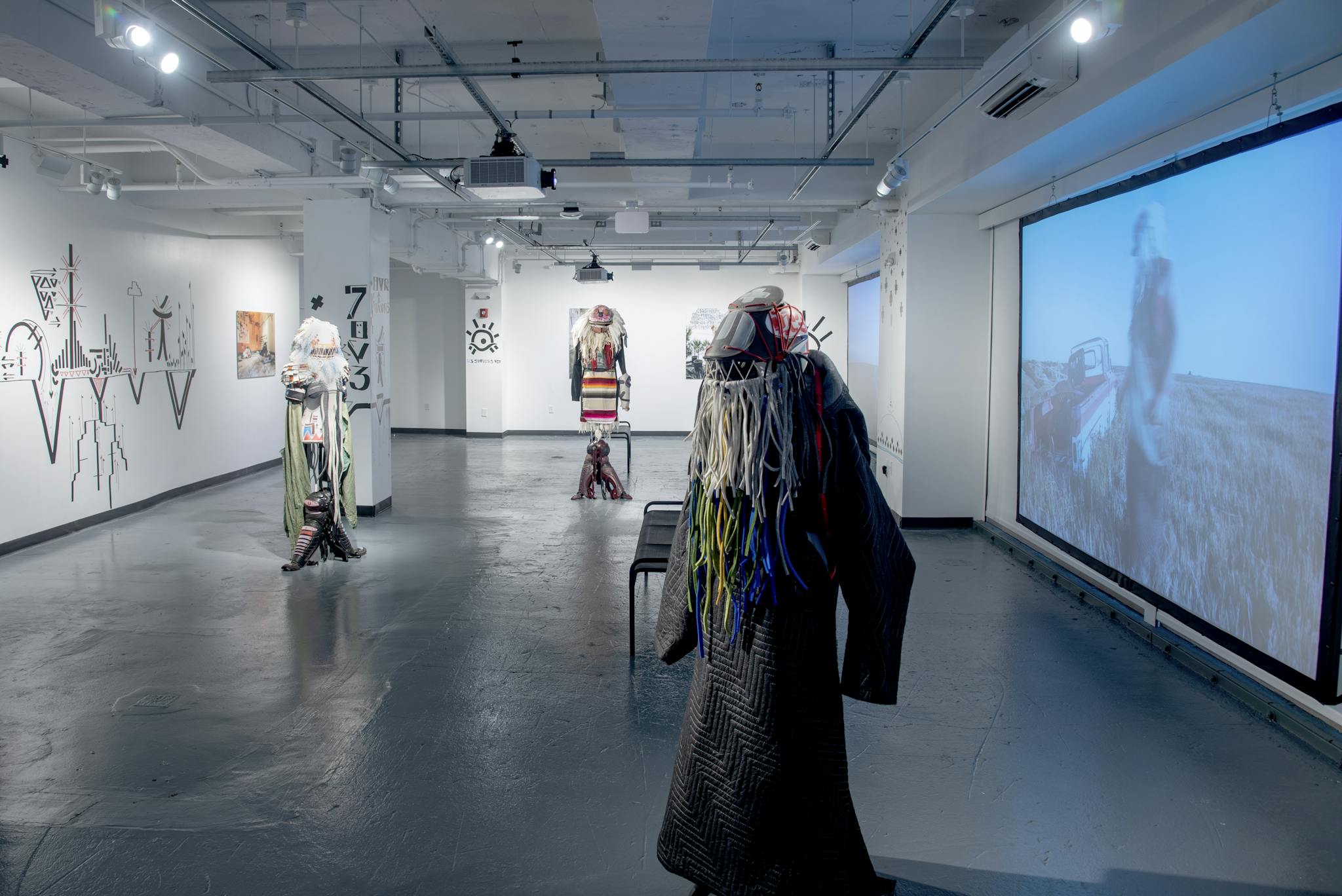At Emerson Contemporary’s Media Art Gallery, “Future Ancestral Technologies: nágshibi” poses a critique of colonialist practices while providing hope for the future through a timeless science fiction narrative. The work of Cannupa Hanska Luger, a New Mexico-based artist who grew up on the Standing Rock reservation, creates a space that looks so far to the future, it feels like a glimpse of the past. Nágshibi, which means ‘to be after’ or ‘to go beyond’ in the Hidatsa language, provides the framework for the show, creating a context outside of linear time in which anything is possible—including the collapse of capitalism. Organized by newly appointed Foster Chair in Contemporary Art Theory and Practice and Distinguished Curator-in-Residence Dr. Leonie Bradbury, “Future Ancestral Technologies” is a whimsical reframing of our inevitable post-apocalyptic future. Dr. Bradbury describes the curating process for this show as a collaborative reflection of Luger’s intentions. Focusing on Indigenous peoples’ connection to the land and the grief that comes with its destruction, this project functions as a site for colonial resistance. While iterations of the “Future Ancestral Technologies” project have been shown previously, most recently at the Ford Foundation gallery in New York City for the show “Utopian Imagination,” this specific combination of objects, photographs, videos, lectures, and performances have never before appeared together.
Set eighty “cycles” after Earth becomes virtually uninhabitable, Luger imagines a period when “the colonizers” have been forced to leave the planet by their own destructive tendencies, and ancient Indigenous cultural practices are not only relevant, but necessary for survival. Here, Luger presents a storyline in which Indigenous people and people of color are protagonists with agency to determine their own futures, even after the colonizers have done their best to destroy them. In Luger’s video, “We Live,” which outlines much of the mythos for the exhibition, the somber voice of a narrator relates the story of how colonizers and the wealthy have mined the earth to create “huge ships” in order to flee the planet, leaving gouging wounds upon the earth in their wake. The objects in the gallery are created in response to the need to ‘clean up’ or atone for the sins of the colonizer, fabricated as items of ritual in a never-ending apology to the earth. Videos demonstrating the use of these ritual materials are spread throughout the gallery, showing unknown figures moving with somber reverence in regalia made of recycled materials that obscure their faces. Despite the destruction inherent to the story, the viewer can’t help but find hope in the peaceful nature of these videos, especially those set in the open plains: the peace of an earth without capitalist machinations serves as a reminder that even when we die out, the earth will survive. Combining technologies of the present with traditions of the past, and blurring the lines between storyteller and visual artist, Luger is able to speak to issues across time and space. He asserts that our current culture of production, materialism, and individualism is a fleeting moment in the grand timeline of our earth’s history that will someday crumble and leave lasting effects.
Situated beneath the high ceilings of the gallery’s main entrance, a large, colorful cloth tipi with collapsible metal support poles stands tall. Luger designed the piece to be easily transportable and self-sufficient: the tipi has solar panels (or at least the impression of solar panels) integrated into its opening flaps to ostensibly provide power for those inside. The tipi, long a symbol of “simple” Native American life in the Eurocentric historical canon, is reframed as a testament to Indigenous resilience and innovation in the face of struggle; the United States government has continuously tried to forcibly assimilate native peoples by barring them from their language and customs, putting their children in boarding schools, removing them from their land with hostility, and placing their sacred objects in museums. Understanding these histories of trauma, and feeling their impacts to this day, Luger uses his artistic practice to explore the radical notion of an Indigenous future, casting doubt on practices that are inherently rooted in colonialism by questioning their existing systems, including those of ‘the museum.’
Throughout the rest of the space, figures with elaborate clothing stand like stoic warriors. Although the suits of armor that adorn these figures have visual ties to sacred Native American objects, the regalia represented here is imagined rather than actual. The recycled components of yarn, sports equipment, and strips of fabric which comprise the regalia are multivalent: the reuse of these items cements Lugers warnings and calls for personal accountability. Despite the powerful message these figures carry, Luger adds a sense of humorous incongruity—one normally doesn’t think of football helmets as being traditional Indigenous attire. The curator provides a context for the suits’ physical presence by showing images of their activation in a previous performance titled “AFRAID NOT.” The inclusion of these photographs, a new development from previous iterations of this exhibition, is helpful in understanding the artist’s body of work and how it affects his current intentions. It is clear that these objects have a life beyond gallery walls, directly challenging colonial ideas of “preservation.” Interspersed between these cinematic stills of Luger’s past performances is a lively depiction of the origin myth behind the exhibition. Luger painted this hieroglyphic history across several walls and columns in the gallery as one of the storytelling performances organized by the curator.
While the work on view represents an imagined future, the exhibition looks to the past and the present through a series of talks, screenings, and performances coordinated by Dr. Bradbury. In keeping with the message of accountability Luger espouses, Larry Spotted Crow Mann—an author, storyteller, and member of the Nipmuc tribe—noted during his lecture that a constant in our universe is that in order for one thing to grow, another must diminish. Every action we take has a reaction, and every time humanity creates something new like houses, clothes, or even artwork, the resources we use are taken from the earth. By bringing Indigenous creatives like Luger and Larry Spotted Crow Mann together, this iteration of “Future Ancestral Technologies” succeeds in its goal of wider influence and education, transporting the viewer outside of simple consideration of the physical objects in the gallery and into consideration of how the greater thematic undercurrents of the exhibition affect their everyday lives and our planet’s collective future.
“Future Ancestral Technologies: Nágshibi” is on view at the Media Art Gallery, Emerson College, 25 Avery St., through December 15.
Cannupa Hanksa Luger’s video installation, “We Live,” can be viewed here.



